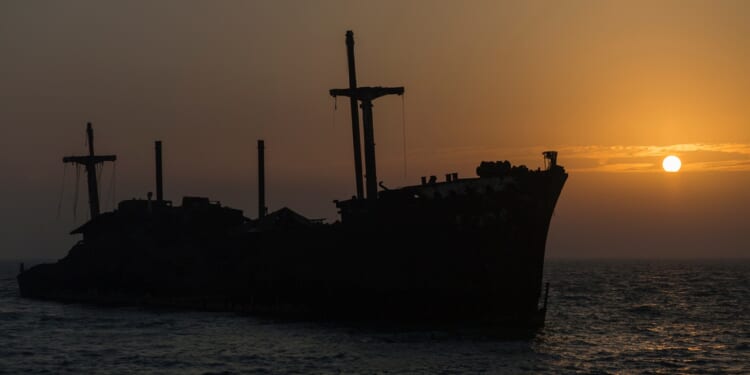The accidental sinking or capsizing of two other Iranian ships over the past decade—the Damavand in 2018 and the Talayieh in 2021—indicates serious deficiencies in the Iranian Navy.
Iran is in the crosshairs of both the United States and Israel for its ongoing development of an illicit nuclear weapons program. Many analysts believe war over this capability might erupt at any moment.
And while the Islamic Republic of Iran should not be underestimated by American and Israeli war planners, they should not overstate its threat to U.S. forces, either. The fact is that Iran has grand ambitions—but a mediocre military to achieve those outsized strategic goals for the region.
Last year’s sinking of the Mowj-class frigate Sahand is a perfect example of this. On July 7, 2024, the Sahand capsized and sank while undergoing repairs in a port near Bandar Abbas. After the event occurred, social media posts showed the frigate tilted on its left side, mostly underwater, and colliding with nearby civilian ships.
The exact cause of this incident remains unknown. But the incident itself points to an overall lack of readiness and unreliable engineering capabilities.
Iran Wants to Save the Sahand—but Probably Can’t
Overall, the Mowj-class frigate program has faced serious criticism for slow construction timelines and incomplete outfitting. The Sahand’s exposure to saltwater during its sinking likely damaged the boat’s electronics and weapons systems, making repairs—if feasible—prohibitively expensive.
Most Iran naval experts insist that the Sahand can still be salvaged. Yet bringing the Sahand back to full operational capacity will be a difficult task. The loss of this warship highlights the fragility of Iran’s naval modernization efforts, despite their best attempts.
Iran’s Mowj-class frigates have struggled with controversy for years. International sanctions have limited Iran’s access to advanced technology, forcing reliance on reverse-engineered or domestically produced systems that may lack reliability. When combined with the Iranian Navy’s dismal, accident-prone record, that does not bode well for its naval threat—and undermines the warnings of those in the West who caution about how underestimated Iran’s threat will be to the region.
After all, it wasn’t only the Sahand that has sunk in port or been damaged due to crew negligence.
The Iranian Navy’s History of Incompetence
The accidental sinking or capsizing of two other Iranian ships over the past decade—the Damavand in 2018, and the Talayieh in 2021—indicates serious deficiencies in the Iranian Navy. Everything from the crew’s training, their understanding of maintenance, and quality control should be in question after the spate of disasters their military has presided over.
Mowj-class frigates are an evolution of the British-designed Vosper Mk 5 (Alvand-class) frigates that Iran’s clerical government inherited from the Shah. The Sahand, launched in November 2012 and commissioned on December 1, 2018, was the third vessel in the Mowj program, following the Jamaran and Damavand.
Built at the Shahid Darvishi Marine Industries Shipyard in Bandar Abbas, Sahand incorporated iterative improvements over its predecessors, including a modernized hull design with sloped sides to reduce radar cross-section (RCS).
The frigate featured a flight deck for helicopter operations, enhancing its anti-submarine warfare (ASW) capabilities, and was equipped with advanced radar, sonar, and electronic warfare systems. Its crew consists of around 140 people, including officers, sailors, and technicians trained to operate its diverse systems.
Sahand’s armament was a key feature, reflecting Iran’s focus on asymmetric naval warfare. The warship was equipped with Noor and Qader anti-ship missiles, capable of engaging targets at long ranges. This frigate possessed surface-to-air missiles for aerial defense. The Sahand had mounted torpedoes, a 76mm main gun, and close-in weapon system (CIWS). All these systems supposedly made Iran a real challenger to the United States and its allies.
But the Islamic Republic of Iran’s navy has had multiple avoidable and highly embarrassing accidents—foreshadowing just how out of their depth they will be when taking on both the United States and Israel.
The Iranians have proven themselves to be their own worst enemy. America should get out of the way and let its enemies destroy themselves.
About the Author: Brandon J. Weichert
Brandon J. Weichert, a Senior National Security Editor at The National Interest as well as a contributor at Popular Mechanics, who consults regularly with various government institutions and private organizations on geopolitical issues. Weichert’s writings have appeared in multiple publications, including the Washington Times, National Review, The American Spectator, MSN, the Asia Times, and countless others. His books include Winning Space: How America Remains a Superpower, Biohacked: China’s Race to Control Life, and The Shadow War: Iran’s Quest for Supremacy. His newest book, A Disaster of Our Own Making: How the West Lost Ukraine is available for purchase wherever books are sold. He can be followed via Twitter @WeTheBrandon.
Image: Shutterstock / Mahsa.

















